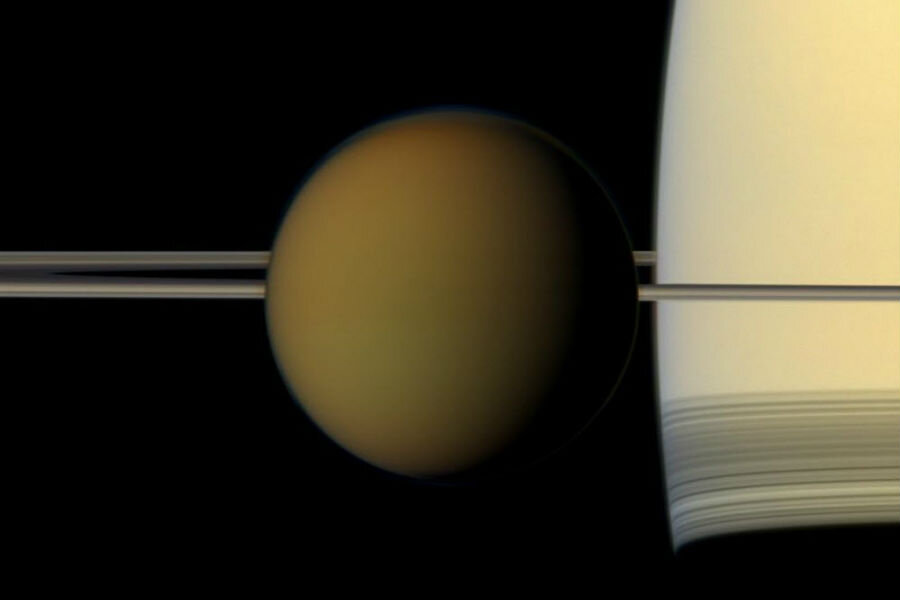Cassini reveals incredible vanishing 'Magic Islands' on Saturn's largest moon
Loading...
Recent images from NASA's Cassini spacecraft, currently touring Saturn and its moons, have revealed Brigadoon-like “islands” on one of Titan's largest seas, features that appear, disappear, then re-appear.
Scientists have whimsically named these “Magic Islands.” Their vanishing act is one of several recent discoveries planetary scientists have made regarding the northern hemisphere's liquid-hydrocarbon seas and lakes at a time when the hemisphere heads toward its summer solstice.
These vast reservoirs of liquid hydrocarbons are centered around the moon's north pole region, where they are thought to play a key role in the moon's equivalent to Earth's water cycle. In Titan's case, it's the methane cycle, where the liquid methane at the surface of the lakes and seas evaporates, rises to condense as clouds, then returns to the surface as methane rain. Liquid methane flows in to streams and rivers, sculpting the moon's surface on their return to lakes and seas.
These features are strikingly similar to processes on Earth, making Titan – Saturn's largest moon – “an explorer's Utopia,” said Alexander Hayes, a planetary scientist at Cornell University during a briefing at a meeting of the American Astronomical Society's Division of Planetary Sciences in Tucson, Ariz. Dr. Hayes is a member of the science team reporting the results at the meeting.
Researchers first discovered a magic island just off of a peninsula jutting into Ligeia Mare, Titan's second largest sea – a body of mainly liquid methane that covers slightly more than 48,600 square miles of the moon's surface.
The team detected it in July 2013 using Cassini's radar. When the team looked again about 16 days later, the feature was gone. On another Cassini pass over Titan in August, the feature reappeared. It was unclear if the feature the radar detected was a surface feature, such as the action of tiny waves, or perhaps represented a geological structure that only revealed itself when the viewing angle was just right.
Cassini's August pass provided the answer when it discovered a similar feature in Kraken Mare, the largest of the moon's northern-hemisphere seas. In addition to radar, Cassini's Visual and Infrared Mapping Spectrometer also spotted a magic-island feature in Kraken Mare. The spectrometer's data suggested that either small waves or wet ground was responsible for the signature the instrument picked up.
The team is leaning to the wave interpretation because given the size of Kraken Mare – it covers some 154,000 square miles, roughly the size of the Caspian or Black Seas – the sea would have had to have lost a fair bit of methane to expose even a shallow bottom at that location and over such a wide area.
Such wave action would be expected as the northern hemisphere warms and kicks up winds.
Cassini also has proven unexpectedly adept at determining the depths of the seas as well as their composition, Dr. Hayes explained.
Based on the work of Marco Mastrogiuseppe, another Cornell researcher, the team learned it could use Cassini's radar as a depth gauge for the seas as well as a tool for mapping the sea floors.
The team aimed the radar straight down at Ligeia Mare during the craft's July 2013 pass to measure features on its surface.
“What was so surprising was that we got a return from the bottom of the sea” as well, Hayes said, based on a new approach to analyzing the data that Dr. Mastrogiuseppe had developed.
The radar measured a depth of about 525 feet below the sea surface. And the unexpectedly strong radar return off the bottom – covering more than 1,000 feet on the round trip below the surface and back – also yielded clues about the composition of the liquid. The team determined that it was mainly methane. The technique can be used to detect a bottom as deep as 650 feet.
This technique has enabled the team to in essence make the first-ever oceanographic measurements on another planet. These measurements have helped researchers identify the liquid in the basins, the basins' depths and volume, and to some extent the relief, or bathymetry, of the bottoms. For example the measurements indicated that Ligeia Mare has about three times the volume of lake Michigan. The team has since applied the approach to other liquid bodies on Titan.
Titan is the scientific gift that keeps on giving, Hayes suggested, adding, “What I find amazing is that despite having been there for 10 years, we can still learn new ways to use the instruments on the Cassini spacecraft.”





